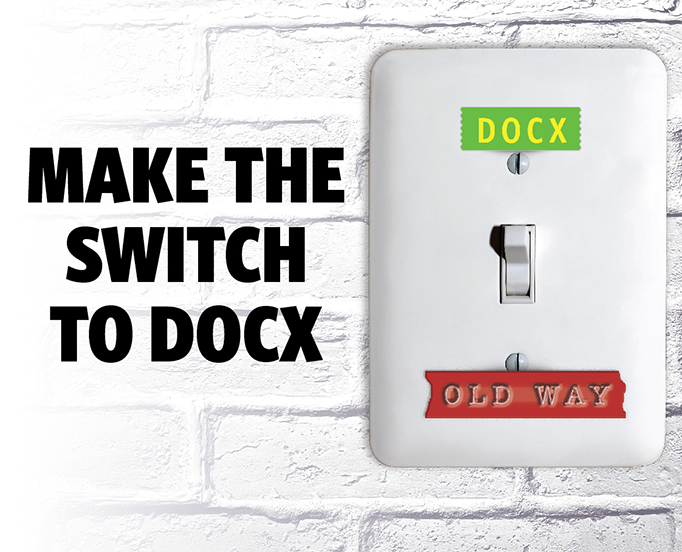Modernizing patent filing with DOCX
Guest blog by Acting Commissioner for Patents Andrew Faile and Chief Information Officer Jamie Holcombe
Update: The USPTO has issued a federal register notice delaying the effective date of the non-DOCX surcharge fee from January 1, 2022 to January 1, 2023, giving applicants more time to adjust to filing their patent applications in DOCX format. Sections of this blog have been updated to reflect the delayed effective date of the surcharge.

DOCX is a word-processing file format supported by many popular applications, such as Microsoft Word, Google Docs, and LibreOffice. As an open standard format, DOCX offers a safe and stable basis for authoring and processing intellectual property documents.
Filing in DOCX provides you with many benefits in the application process, including:
- Increased efficiencies: eliminates the need to convert structured text into a PDF for filing.
- Higher data quality: reduces conversion errors that can occur when converting to a PDF file.
- Smarter interface: detects common errors, such as formatting errors, and provides instant feedback to prevent unnecessary delays in processing your application.
- Privacy: provides automatic metadata detection (e.g. track changes and comments) and removal features to support the submission of only substantive information in the DOCX file.
- Improved application quality: provides content-based validations pre-submission, identifying issues up front and allowing for them to be addressed before examination begins.
- Ease of use: provides automated document indexing.
- Compatibility: eliminates the non-embedded font error, the most common obstacle in uploading a PDF, by uploading your file with supported fonts.
We believe that meaningful improvements to our application processes can only happen through collaboration with our users. To that end, we received helpful feedback last year after the publication of our federal register notice that prompted us to make a few changes as we transition to the DOCX format.
First, we delayed the effective date for the non-DOCX surcharge fee, to provide more time for applicants to transition to this new process, and for the USPTO to continue our outreach efforts and address customer concerns. We’ve also made office actions available in DOCX and XML formats and further enhanced DOCX features, including accepting DOCX for drawings in addition to the specification, claims, and abstract for certain applications.
Additionally, based on what we’ve heard from our customers, we are adopting the submitted DOCX files as the authoritative document, otherwise referred to as the source or evidentiary copy (read the federal register notice). This will simplify the filing process, allowing the applicant to only review the DOCX files before submission rather than reviewing the USPTO-generated PDF version.
We look forward to continuing our engagement with the public on the DOCX transition so we can better serve America’s innovation community. We will be hosting DOCX training sessions on a regular basis to provide more information, demonstrate how to file and retrieve DOCX files in Patent Center, EFS-Web, and PAIR, and answer any questions. Applicants can also file test submissions through Patent Center training mode to practice filing in DOCX. In addition, we will offer a listening session this fall to gather feedback and suggestions to further improve DOCX features.
For more information and to view frequently asked questions, visit the DOCX page of the USPTO website. If you need assistance, please contact the Patent Electronic Business Center at ebc@uspto.gov or 866-217-9197.
Posted at 06:49AM May 25, 2021 in patents | Comments[26]


Posted by Erik J. Heels on May 25, 2021 at 07:43 AM EDT #
Posted by Erica Layman on May 25, 2021 at 07:46 AM EDT #
Posted by Greg Magel on May 25, 2021 at 08:01 AM EDT #
Posted by Dorothy Hauser on May 25, 2021 at 08:01 AM EDT #
Posted by Russell C. Gache on May 25, 2021 at 08:36 AM EDT #
Posted by Kevin Klughart on May 25, 2021 at 08:47 AM EDT #
Posted by Anonymous on May 25, 2021 at 09:22 AM EDT #
Posted by Daniel on May 25, 2021 at 09:22 AM EDT #
Posted by Alan Flum on May 25, 2021 at 09:57 AM EDT #
Posted by David Boundy on May 25, 2021 at 12:45 PM EDT #
Posted by David Boundy on May 25, 2021 at 01:35 PM EDT #
Posted by Frank H Foster on May 25, 2021 at 01:51 PM EDT #
Posted by Axel Nix on May 26, 2021 at 07:59 AM EDT #
Posted by John Heithaus on May 26, 2021 at 09:41 PM EDT #
Posted by Cheryl Fillekes on May 27, 2021 at 06:11 AM EDT #
Posted by Cheryl Fillekes on May 27, 2021 at 06:19 AM EDT #
Posted by Kevin Klughart on May 27, 2021 at 07:37 AM EDT #
Posted by Kevin Klughart on May 27, 2021 at 07:47 AM EDT #
Posted by John Heithaus on May 27, 2021 at 02:32 PM EDT #
Posted by 10.240.16.80 on May 29, 2021 at 06:07 AM EDT #
Posted by MR Linux on May 31, 2021 at 08:06 AM EDT #
Posted by David Scheer on June 01, 2021 at 02:07 AM EDT #
Posted by Chris King on June 11, 2021 at 09:51 PM EDT #
Posted by MD Ashraf on June 11, 2021 at 11:39 PM EDT #
Posted by Franco Serafini on June 21, 2021 at 10:32 AM EDT #
Posted by Steven M Hoffberg on July 06, 2021 at 12:08 PM EDT #